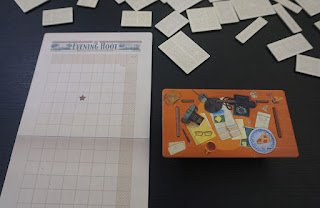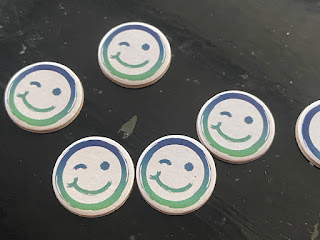Tuesday, 28 November 2023
Fit to Print
Friday, 24 November 2023
Completing Dorfromantik
Younger daughter Chen Rui and I have "completed" Dorfromantik, after playing 10 games. "Completed" as in we have unlocked all the game components and rules. We actually did that at the end of Game 9. We played Game 10 with all components in play. The campaign doesn't end there. There is no end, technically. It's just that there won't be new components to unlock.
Spoiler alert! Photos and descriptions below include content which is only available from Game 2 onwards. If you want to fully experience the component unlocking yourself, you may not want to read on. You can read the spoiler-free blog post here. I don't think spoilers will affect your enjoyment much though.
Saturday, 18 November 2023
TTGDMY playtesting session
Friday, 10 November 2023
boardgaming in photos: Innovation, Race for the Galaxy, Carcassonne
8 Oct 2023. I played Attika with younger daughter Chen Rui. This was quite a brutal game. I almost connected two temples, but Chen Rui cut me off. We had instances of starting new settlements to grab land and resources from each other. The more I play this game, the more I appreciate it. I have an urge to find an English version. Mine is German. The game was first released in 2003, and it has never been reprinted. That's a shame. It's a great game!
13 Oct 2023. I played Innovation with Allen. I'll never tire of this game. This is Carl Chudyk's magnum opus. It is an evergreen in my top ten games. It's an unusual game, and also a little challenging to learn, but once you get into it, it is full of surprises and crazy situations. It's a wild ride.
In our game, this was the card which helped me the most - Industrialization. It didn't directly score points, but it helped me draw many cards to be added to my empire. More cards meant more icons, and that meant a much more powerful empire. I could bully Allen, I didn't have to worry about him piggybacking on my dogma powers, and I could piggyback on his dogma powers.
14 Oct 2023. I still play Race for the Galaxy against AI's once in a while. In this particular game I managed to score exactly 100pts. I normally play against 2 other AI players, and my winning rate is probably below a third. So I'm not actually very good at this. It's just that I usually take screenshots only when I win. Most of the time things are not that glamourous.
The scores for this particular game wasn't high. What was unusual was I tied one AI for the win. We were both at 42pts. The tiebreaker in Race for the Galaxy is remaining hand cards and goods. We tied for that too, at 8. Ties are quite rare, especially when all three expansions are in play.
15 Oct 2023. I did Carcassonne with my wife Michelle and younger daughter Chen Rui. Michelle and I are veterans, but Chen Rui is quite new to the game. Michelle knew I was the biggest threat and she kept persuading Chen Rui to gang up on me.
In this photo, Chen Rui (black) was first to start a castle in this area. I (green) was next, placing my meeple on the castle on the left. I placed a regular meeple, so that if Chen Rui and my castles merged, we would both score points for the combined castle. Later Michelle (red) created a new castle on the right. She placed a big meeple, which had the strength of two meeples. If her castle merged with ours, her big meeple would overpower both of ours, leaving us no points. I told Chen Rui, see what your mom is doing to you; you should listen to dad.
Eventually Chen Rui the newbie won the game. Michelle and I had been too busy tripping each other up.


















































